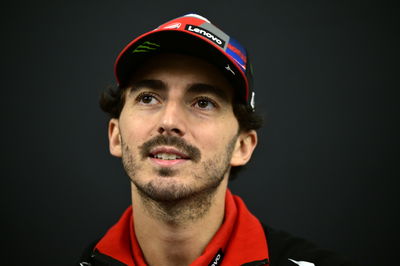What is MotoGP?
The single tyre rule for 2009 has reignited the debate over what the MotoGP World Championship should stand for.
The move from 500cc two-strokes to 990cc four-strokes in 2002 saw the MotoGP championship increasingly branded as a 'prototype' class, the two-wheeled equivalent of Formula One and a place where the fastest, most exotic, motorcycles are raced by the best riders in the world.

The single tyre rule for 2009 has reignited the debate over what the MotoGP World Championship should stand for.
The move from 500cc two-strokes to 990cc four-strokes in 2002 saw the MotoGP championship increasingly branded as a 'prototype' class, the two-wheeled equivalent of Formula One and a place where the fastest, most exotic, motorcycles are raced by the best riders in the world.
That is how 'MotoGP' would introduce itself to a stranger at a party (or a potential sponsor) and also how MotoGP sought to distance itself from the visibly similar World Superbike Championship - a distinction that is yet to penetrate into most mainstream minds. To the general public, the main difference between MotoGP and World Superbike is simply the riders.
The end of open tyre competition in MotoGP removes a further element of MotoGP's prototype philosophy - but does it really matter?
After all, every motorcycle on the MotoGP grid has been powered by a four-cylinder engine since the start of 2007. Not much radical experimentation there then, especially since WSBK features both twin and four cylinder machines, but no-one really complained.
Even MotoGP's perceived role as a proving ground for cutting-edge technology, essential to improve future road bikes, has come to little.
Ducati produced a limited edition road replica of its Desmosedici, but BMW, Aprilia and KTM have all decided that MotoGP experience was unnecessary for the creation of their new high-performance road bikes - which they will refine and promote by racing in World Superbike (Superstock in KTM's case) instead.
If a new high performance motorcycle can be built by a major manufacturer without any MotoGP input, it is hard to see how road tyre development will grind to a halt now that open competition has been extinguished. Anyway, when was the last time a road rider popped out to buy a qualifying tyre?
So should MotoGP re-evaluate it's propose, admit it's main power is as a marketing tool and concentrate on providing entertainment under a simple 'best riders, fastest bikes' banner? From now on, when in doubt, should the show always come before everything else (except safety)?
Many MotoGP fans, and indeed motorcycle racing fans in general, continue to be mystified at how Formula One, a championship which offers so little actual racing action, continues to prosper.
MotoGP continues to be heavily influenced by F1. So how does F1 define its purpose?
Like MotoGP, the answer will be different depending on the person asked and their relationship with the championship, but this is how a young F1 engineer described the purpose of a Formula One team at the start of a guest lecture for engineering students at a British university, around five years ago.
"The purpose of a Formula One team is to generate income for its sponsors."
No mention of winning races or world championships, although those are presumably the best - but far from only - methods of maximising income for sponsors. The engineer is now the technical director of a major British-based F1 team.
And just how important is the hi-tech argument for the likes of F1 and MotoGP anyway?
After all, as long as a MotoGP machine continues to lap a circuit faster than any other racing motorcycle then most fans will perceive it to be technically superior, whatever the actual cost of its individual components.
Perhaps MotoGP should remember the following phrase, used to combat objections to F1s increasingly strict technical regulations - including a single tyre supplier and a freeze on engine development:
'Put all the engineers on one side of a room and all the drivers on the other, then let the fans in and see who they go and talk to.'
But could a balance have been struck whereby tyre competition was allowed to continue in MotoGP?
Tyres are the single most important component of a racing motorcycle, yet there are no technical restrictions on things like materials or construction, only a maximum rim width. Compare that with the detailed fuel regulations, for example, which list the precise chemical composition allowed.
Might a way have been found to restrict large areas of tyre development, in the same way that other areas of a motorcycle are limited, thereby reducing the potential performance difference between brands? Could corner speed have been addressed by limiting the amount of compound difference allowed between the middle and sides of a tyre for example?
That might have addressed the safety/corning speed issue highlighted as the official reason, along with costs, for introducing the new rule - although Michelin stated that it was never given a chance to make any proposals:
"Michelin regrets not being able to contribute to the organisers' important discussions to improve rider safety and reduce costs," said part of a statement announcing that Michelin would not bid for the exclusive 2009 tyre rights.
Bridgestone is set to be officially announced as the exclusive MotoGP tyre supplier by October 18.












